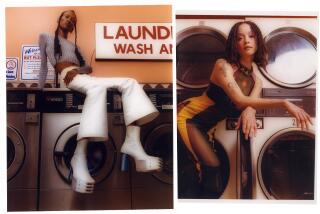Trying to Take Cleaners to the Cleaners
- Share via
What do you do when your laundry comes back from the cleaners with holes in it?
If your dry cleaner loses your shirt or turns your purple silk blouse into a bright green cotton print, you may have a valid legal claim for damages--but only if the dry cleaner was unreasonably careless. So don’t rush off to sue just quite yet.
When you give your clothes to your local dry cleaner, you have created what is legally called a bailment. The cleaner is known as a bailor and has a legal obligation to take care of your property.
Comes Back Damaged
If the shirt you turned in was in good condition and it comes back damaged, and if the cleaner did not meet the standards of a reasonably prudent dry cleaner--for instance, he or she forgot to follow the cleaning instructions on the little tag--you may be able to make the dry cleaner pay for your loss.
Since one ruined shirt is unlikely to be worth the expense of a lawyer, you’ll probably want to take your case to small-claims court, which handles disputes worth less than $1,500 and where lawyers are not needed. But before you try to find your local small-claims court, you should try to resolve the dispute on an informal basis.
The Tel Law Service, sponsored by the Riverside County and San Bernardino County Bar associations, has an informative five-minute tape about dry cleaning. Call (714) 824-2300 and ask to listen to tape No. 167. You will be charged by the phone company if it is a toll call from your area.
If you can’t work things out with the dry cleaner directly, send your complaint in writing to the state Board of Fabric Care, which will try to mediate a settlement. The address is 1430 Howe Ave., Sacramento, Calif. 95825. The telephone number in Sacramento is (916) 920-6751. The Board of Fabric Care also has a telephone number in Los Angeles, (213) 620-4130, and one in San Diego, (619) 920-6751.
The board can arrange for a laboratory analysis to determine if shoddy material was to blame for the problem. If that’s the case, you’ll have to go after the manufacturer or the haberdasher, not the dry cleaner. The lab test usually takes about three to five weeks, and either the dry cleaner or the customer must to pay for it.
Proof of Negligence
Before you sue, you might want to ask the dry cleaner about his training and experience, which may be relevant in court. You might also check to make sure that your dry cleaner has his state license, which must be posted in a conspicuous place. It should be renewed every two years.
If you decide to sue, you’ll have to convince the small-claims judge--who is usually a lawyer serving on a voluntary basis--that the dry cleaner was negligent, that is, unreasonably careless.
Tell the judge what kind of condition the garment was in when you took it to the cleaner. And be sure to stress, if it’s true, that the dry cleaner inspected the garment before he accepted it for cleaning.
If you want to sound like a lawyer and toss around Latin phrases, try res ipsa loquitur , which means “the thing speaks for itself.” But you’ll only be able to do that if you have the tattered garment to show the judge. On second thought, forget about the Latin and just show the judge the evidence.
The cleaner will no doubt offer a defense in the suit by saying that it was not his fault, that the unusual fabric was to blame, that you purchased shoddy goods in the first place or that the hole or rip was already in the shirt.
These are all valid defenses.
The dry cleaner will not be held responsible for damage that stems from the garment’s faulty construction.
He may also assert that you have waived your right to sue by acceptance of a disclaimer, which is sometimes found in fine print on the back of your receipt. It is like a contract, but if you never saw it, you could not have legally accepted it. Even if you read it, some courts won’t enforce such disclaimers. And they will certainly not be valid against willful damage to your property.
Convincing the Judge
Assuming that the cleaner was negligent, you’ll still have to convince the judge how much you should win. You won’t be entitled to the $200 you paid for that silk blouse. You are probably only entitled to the fair market value--the depreciated value--of your garment at the time you took it to the cleaner--not the replacement value, what it will cost to buy a new one.
In one recent small-claims case, a Santa Monica man brought in a pair of pants that had been returned to him by his cleaner. The problem was that the pants were not his. He had brought a business suit to be cleaned, and when he picked it up, he received his jacket but someone else’s pants. The dry cleaner insisted that the man must have brought in the wrong pair to begin with, but the small-claims court judge believed the customer. It ordered the cleaner to pay for the missing pair of pants.
Attorney Jeffrey S. Klein, a member of The Times’ corporate legal staff, cannot answer mail personally but will respond in this column to questions of general interest about the law. Do not telephone. Write to Legal View, You section, The Times, Times Mirror Square, Los Angeles 90053.


